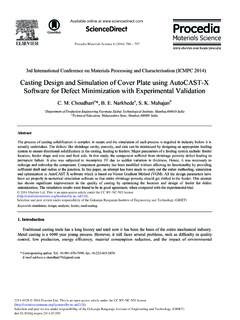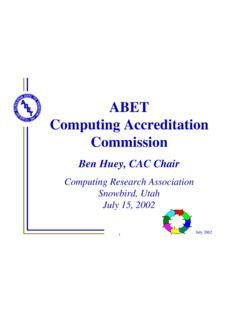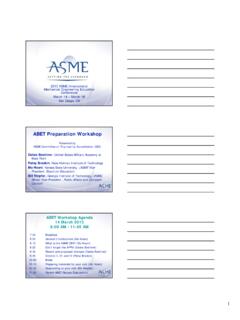Transcription of IT SYSTEMS PERSPECTIVES Global Trends in …
1 See discussions, stats, and author profiles for this publication at: Trends in computing AccreditationArticle in Computer November 2009 DOI: Source: DBLPCITATIONS7 READS582 authors:Some of the authors of this publication are also working on these related projects:Data Quality in the Classroom View projectnone - I have retired View projectHarry L. Reifretired25 PUBLICATIONS 181 CITATIONS SEE PROFILER ichard G. MathieuQueens University of Charlotte60 PUBLICATIONS 908 CITATIONS SEE PROFILEAll content following this page was uploaded by Richard G. Mathieu on 09 December user has requested enhancement of the downloaded Trends in computing Accreditation Me m b e r s o f t h e international com-puting communit y are actively working to facilitate the mobility of computing and IT-related professionals through the recognition of equivalency of accredited academic programs lead-ing to a degree in a computing or IT-related discipline.
2 A s of D e c ember 20 08, eig ht organizations ABET (US), ABEEK (Korea), ACS (Australia), BCS (United K ingdom), CIPS (Ca nad a), HK IE (Hong Kong), IEET (Chinese Taipei), and JABEE ( Japan) had signed the Seoul Accord ( ) agreeing to work together to become recognized as the interna-tional authority for quality assurance for education in computing and IT-related professions and to promote and develop best practices for the improvement of education in comput-ing and IT-related disciplines. Within the EU, participants in the multiyear Bologna Process are adopt-ing a system of comparable higher education degrees to overcome obsta-cles to the free movement of students, teachers, and researchers and to pro-mote European cooperation in the quality assurance of higher education programs ( ).
3 At the same time, the Interna-tional Federation for Information Processing (IFIP) has initiated the International Professional Practice Program (IP3) with the goal of creat-ing a set of globally recognized and trusted professional certification schemes that represent the hallmark of true IT professionalism ( ).INCREASE IN ACCREDITATIONA ccreditation of computer science, information SYSTEMS , IT, computer engineering, software engineering, and other related programs is undeni-ably growing. For example, ABET s computing Accreditation Commission ( ) which accredits computer science, informa-tion SYSTEMS , and IT programs saw a steady increase from 1996 (140 accredited programs) to 2000 (163 accredited programs) to 2004 (215 accredited programs) to 2008 (309 accredited programs).
4 If programs in computer engineering, software engi-neering, and telecommunications are included, ABET accredited 621 com-puter-related programs in 2008. Many institutions are achieving high placement rates for their gradu-ates. There is widespread recognition that accreditation helps students and their parents choose quality col-lege programs; enables employers to recruit graduates they know are well-prepared; is used by registration, licensure, and certification boards to screen applicants; and provides insti-tutions a structured mechanism to assess, evaluate, and improve their programs many of the traditional and longer-lived engineering fields, the computing disciplines are a rela-tively new phenomenon.
5 As they have become essential components of sci-entific and business environments, the number of computing -related dis-ciplines has grown beyond computer science and computer engineering to include soft ware engineering, information SYSTEMS , IT, health infor- Harry L. Reif and Richard G. Mathieu James Madison UniversityAs computing accreditation increases, three Trends are emerging: clarified definitions of disciplines, a unified approach to accreditation, and a focus on graduates long-term 102I T S Y S T E M S P E R S P E C T I V E SPublished by the IEEE Computer Society0018-9162/09/$ 2009 IEEE Authorized licensed use limited to: James Madison University. Downloaded on December 7, 2009 at 08:47 from IEEE Xplore.
6 Restrictions apply. 103 NOVEMBER 2009an institution s computing program. It is also a method for sharing and adopting appropriate best practices among all computing programs. As we examined ABET s work, three sig-nificant Trends , in the process of defining appropriate criteria to use in evalu-ating computing programs, the CAC has defined three distinct disciplines: computer science, information sys-tems, and IT. In addition, ABET s Engineering accrediting Commission (EAC) has clearly defined academic programs in computer engineer-ing, sof t wa re engine er ing, a nd telecommunications. While a wide diversity of program names is still being offered, as time moves forward, there appears to be greater common-ality of program names centered on these , as institutions embrace accreditation and as accrediting bodies provide greater services, there is increased demand for the harmo-nization of evaluation criteria so that institutions can repurpose and reuse as much data as possible to support the accreditation of multiple programs without having to recast, reformat, and otherwise revise the data to suit each accrediting body s seemingly unique.
7 Accreditation requirements have evolved from a prescriptive set of courses and course content requirements to a set of mission-driven requirements that contain some common elements but are uniquely shaped by each institu-tion through a process that involves alumni, advisory boards, faculty, and students. This evaluation meth-odology requires each institution to set expectations for graduates that extend beyond the classroom and the temporal duration of each student s formal degree DEFINITIONS OF DISCIPLINESAs the field of computing continues to evolve, definitions of computing -related disciplines are becoming more clarified. Perhaps the greatest adva nce has occurred with the use of com-puter science as a program name.
8 While variations such as comput-ing science and computer software engineering still exist, many poten-tial students and employers have a good idea of what competencies to expect from a computer science graduate. The use of information SYSTEMS and information technol-ogy as core elements in programs names is becoming increasingly common, and work continues on establishing a common set of expec-tations regarding the competencies that graduates of these degree pro-grams should part of establishing its criteria for evaluating computer-related pro-grams, ABET/CAC has defined specific criteria that distinguish computer science, information SYSTEMS , and IT degree programs. In seeking ABET accreditation, schools must align the names of their programs with these cr iter ia do not preclude programs specifying additional com-petencies beyond the minimal criteria that their graduates will possess.
9 This encourages programs to focus their curricula on meeting the needs of specific sectors of future employers matics, and library science to name but a the past decades, organiza-tions, including the IEEE Computer Society ( ) and the ACM ( ), have made efforts to codify model curricula in computer science, information SYSTEMS , and IT programs, but there is no universal agreement on what competencies graduates of these programs should be able to demonstrate. This contrasts with the explicit licensure require-ments found in accounting, medicine, and many engineering , there is increasing recog-nition that computing professionals require continuing education and in some cases verification of their cre-dentials.
10 For example, the Computer Society has created an e-Learning Campus ( ) with access to more than 3,000 online courses and online books from leading techni-cal publishers, as well as the CSDA (Certified Soft ware Development Associate) and CSDP (Certified Soft-wa re Development Professiona l) certifications in software engineer-ing and development. For these reasons it makes sense to examine the state of accreditation and the work being done to unify accreditation and professionalization processes worldwide. ACCREDITATION TRENDSI nternat iona lly, ma ny bod ies accredit computing programs. In the US, the predominant organization that has emerged as the accredit-ing body for computing programs is ABET, in particular the computing accrediting Commission (CAC) that operates under the ABET umbrella.



















